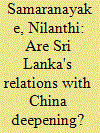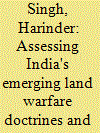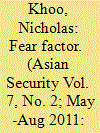| Srl | Item |
| 1 |
ID:
106705


|
|
|
|
|
| Publication |
2011.
|
| Summary/Abstract |
During the past few years, Sri Lanka appears to have forged closer relations with China. Sri Lanka welcomed Chinese investment in building a port in Hambantota, arms from China for use in its civil war, and "dialogue partner" status in the Shanghai Cooperation Organization. Such high-profile moves have unnerved analysts fearing the rise of Chinese influence in the Indian Ocean region. A first-time, systematic analysis of the trends in Sri Lanka's economic, military, and diplomatic relations with China reveals that ties have indeed been strengthening. However, Sri Lanka is neither bandwagoning with nor balancing China, as structural realism predicts. More attention should be devoted to explaining the security thinking of small states that are not following such predictions in response to the emergence of a regional hegemon.
|
|
|
|
|
|
|
|
|
|
|
|
|
|
|
|
| 2 |
ID:
106707


|
|
|
|
|
| Publication |
2011.
|
| Summary/Abstract |
This article attempts to locate and assess the sources of India's land warfare doctrines and capabilities. It begins by briefly examining the Indian army's significant combat experience in dealing with the external and internal security threats during the past six decades. The first section analyzes the security challenges and threats that presently drive the evolution of India's land war-fighting doctrines and capabilities. The next section explains the military imperatives that are driving this doctrinal change. In the next section, the current status of India's land war-fighting capabilities is discussed. The subsequent section examines the institutional limitations that inhibit organizational change, and the final section highlights how these doctrinal and capability gaps might be addressed in the future.
|
|
|
|
|
|
|
|
|
|
|
|
|
|
|
|
| 3 |
ID:
106703


|
|
|
|
|
| Publication |
2011.
|
| Summary/Abstract |
In the face of China's seemingly inexorable rise, how fearful are the key actors in Northeast Asia? Relatedly, how fearful are they likely to be in the future? The academic debate on these questions is characterized by starkly contrasting answers. A typology of the literature is developed whereby analysts are categorized under the rubric of fear deflation, fear inflation, and fear qualification. Through an analysis of empirical survey data and developments during the 2000-2010 period, this article contends that the most appropriate way to characterize Northeast Asian responses to China's rise is via the lens of qualified fear. Through it, one can see that the states on China's periphery are - contrary to the arguments of fear deflaters - exhibiting qualified fear at how China's rising great powers capabilities are wielded. At the same time, levels of fear have not, and arguably will not, escalate to levels posited in the fear-inflation perspective.
|
|
|
|
|
|
|
|
|
|
|
|
|
|
|
|